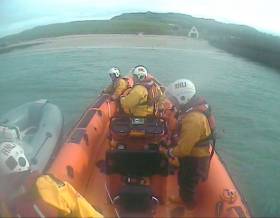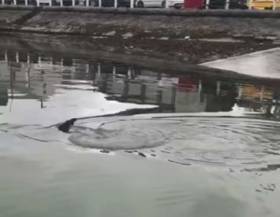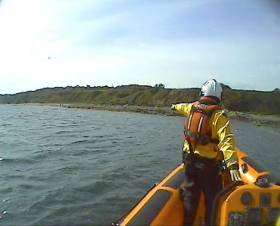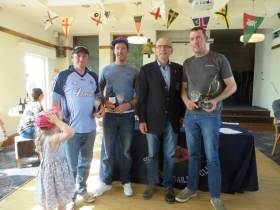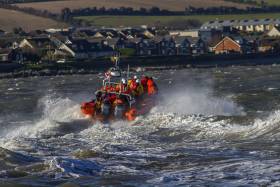Displaying items by tag: Skerries
Skerries Lifeboat Rescues Fishermen From Sinking Razor Boat
#RNLI - Skerries RNLI rescued two fishermen from a sinking razor fishing boat near Laytown early this morning (Thursday 2 November).
Shortly before 5.30am, Dublin Coast Guard received an emergency call from the skipper of a razor fishing boat with two men on board that was taking on water off Laytown and was beginning to list dangerously.
Lifeboats from both Skerries RNLI and Clogherhead RNLI were requested to launch to assist the casualty.
Volunteers from Skerries RNLI launched their Atlantic 85 inshore lifeboat Louis Simson with Emma Wilson at the helm and crewed by Eoin Grimes, Steven Johnson and Jack Keane.
Weather conditions at the time were fair with a Force 1-2 northwesterly wind.
The lifeboat proceeded to the area off Laytown given as a position by the casualty vessel. There was a number of razor fishing vessels in the area, but the lifeboat soon located the casualty off the mouth of the River Nanny, where it was grounded and was being overcome by the rising tide.
Clogherhead RNLI arrived on scene shortly afterwards and stood by while the inshore lifeboat was alongside the stricken boat.
The two fishermen were taken on board the lifeboat, where they were assessed before being brought safely back to Skerries.
Speaking about the callout, Wilson said: “When we got on scene, it was quite difficult to spot the fishing vessel as it was almost underwater and there was only one remaining light in the wheelhouse.
“The crew did the right thing in calling for help, wearing their lifejackets and staying with the boat for as long as possible.”
Medical Emergency On Lambay Island Prompts Skerries Lifeboat Launch
#RNLI - Skerries RNLI launched yesterday evening (Sunday 22 October) after receiving reports of a medical emergency on Lambay Island.
Shortly after 8.30pm, the alarm was raised by a member of the crew when they received a call from Lambay Island, indicating that a person was unwell and requiring immediate medical assistance.
Skerries RNLI volunteers launched their Atlantic 85 inshore lifeboat Louis Simson with David Knight at the helm and crewed by Steven Johnston, JP Tanner and Jack Keane.
The lifeboat proceeded to the island where they went ashore and began to administer first aid to the casualty — as well as prep a landing area for the Dublin-based Irish Coast Guard helicopter Rescue 116, who transferred the casualty to a waiting ambulance on the mainland for treatment at Beaumont Hospital.
“There were multiple rescue agencies involved in this rescue and it’s great to see everyone working so well together,” said Skerries RNLI lifeboat press officer Gerry Canning. “Our thoughts are with the casualty tonight and we wish them a speedy recovery.”
In other rescue news, PSNI officers have been praised for their “swift action” in saving a man whose car entered Lough Neagh in the early hours of yesterday morning.
As the Belfast Telegraph reports, four officers entered the water to free the man, who was unresponsive, from the partial submerged Volkswagen. He was later transferred to hospital with suspected hypothermia.
Two Midweek Callouts Within Hours For Skerries Lifeboat
#RNLI - Skerries RNLI launched yesterday afternoon (Thursday 12 October) for the second time in less than 24 hours.
Shortly after 12pm, Dublin Coast Guard received information that a RIB with one person on board had suffered engine failure north of the harbour at Lambay Island.
Skerries RNLI were tasked and the lifeboat was launched with volunteer Eoin Grimes at the Helm and crewed by Joe May, David Knight and Jack Keane.
Arriving at Lambay, the lifeboat crew spotted the vessel which had put out an anchor. A tow was established and the boat was towed safely to port.
Just hours before, shortly before 9pm on Wednesday (11 October), the lifeboat escorted a razor fishing vessel into Skerries Harbour.
The vessel had contacted Dublin Coast Guard for clarification on a navigational issue while approaching Skerries for an unscheduled stop. They were also having some slight mechanical problems with their steering.
It was decided as a precaution to request the lifeboat to escort the vessel to shore. On that occasion Joe May was on the helm, and the crew consisted of Conor Walsh, Jack Keane and JP Tanner.
Gerry Canning, lifeboat press officer for Skerries RNLI, said: “Both these call outs were to experienced seagoers who were just unlucky. Things can go wrong at sea no matter how prepared you are.
“Our volunteer crew are ready to respond 24/7 and it’s great to see some of our new volunteers gaining invaluable experience.”
Sailing Coach Spots 'Shark' in Skerries Harbour, County Dublin (VIDEO)
Sailing instructor Kerri-Ann Boylan was out coaching kids in Optimist sailing dinghies at the weekend when she spotted a fin in the water in Skerries Harbour in North County Dublin.
'As I brought the kids into land and about to let them jump out of my boat we spotted a fin', she wrote on social media on October 10th.
'It's a very rare sight of a 'shark' being in that close to land and in the Irish Sea,' she added.
Skerries Lifeboat Responds To Reports Of Vessel On Fire
#RNLI - Skerries RNLI launched on Thursday evening (14 September) after the Irish Coast Guard received a number of calls reporting a vessel on fire north of Balbriggan.
The lifeboat was tasked with volunteer Conor Walsh at the helm and crewed by Stephen Crowley, Steven Johnson and JP Tanner.
The fire was visible from the boathouse, and once the volunteers launched their Atlantic 85 inshore lifeboat, they navigated directly to the scene.
As they approached the area, it soon became apparent that the fire was actually a large gorse fire on the shoreline, and the emergency services had arrived to deal with it. The lifeboat was stood down and returned to station.
Speaking about the callout, Skerries RNLI lifeboat press officer Gerry Canning said: “It was quite deceptive to look at, and you can understand how it may have looked like it was actually a fire at sea.
“In this case it was a false alarm, but with good intent.”
Skerries Lifeboat Launches To Report Of Stranded Fisherman
#RNLI - Skerries RNLI launched on Saturday morning (2 September) to a report of a fisherman stranded on rocks near Balbriggan.
Shortly after 11am, Dublin Coast Guard received a call from a member of the Garda that a sea angler had been cut off by the rising tide and was stranded on rocks at the shoreline near Ardgillan Park, just south of Balbriggan.
Skerries RNLI were tasked and the lifeboat was launched with volunteer Robert Morgan at the helm and crewed by David Knight, Gerry Canning and Jack Keane.
The lifeboat proceeded directly to the area indicated by the caller, heading initially towards a well-known outcrop of rocks that extends out a distance into the sea.
Once on scene, the crew began an initial search of the area. They then noticed a garda on the shore waving to attract their attention.
The lifeboat was manoeuvred in very shallow waters against a strong breeze to be close enough to shore for a member of the crew to go ashore and speak to them. It transpired that the fisherman, once alerted to his predicament by the Garda had waded ashore and was no longer in danger.
The lifeboat was stood down and returned to station.
Speaking about the callout, Skerries RNLI lifeboat press officer Gerry Canning said: “In this case, the man hadn’t even realised that he had been cut off by the rising tide and was in a dangerous situation. Thankfully the Garda were able to alert him and he managed to wade ashore.
“If you see anyone in danger in or near the water, dial 999 and ask for the coastguard.”
#RNLI - Lifeboat crews from Ireland will feature in a new 12-part Last year alone, RNLI lifeboats in Ireland documentary for the BBC.
Saving Lives at Sea, showcasing the lifesaving work of the RNLI, starts next Wednesday 16 August at 8pm on BBC Two.
And the first episode will include the dramatic rescue of three fishermen from a sinking trawler and the rescue of 30 people from the Astrid tall ship in Kinsale.
The 12-part series features real rescues carried out by the charity’s lifeboat crews around Ireland and the UK, and gives a unique insight into the lives of the charity’s volunteer lifeboat crew members, who rescue thousands of people and save hundreds of lives around our coastline every year.
From Ireland, the series will feature lifeboat crews from Castletownbere and Kinsale in Cork, Skerries in Dublin and Bangor on Belfast Lough.
Castletownbere will be in episode three, as the crew rescue a lone sailor in storm conditions and rescue two fishermen from a boat that sinks.
Saving Lives at Sea features real-life rescue footage accompanied by heart-warming and emotive testimonials from the crew and the people they rescue.
The series has been filmed over the past year, with lifeboat crews using RNLI and special cameras and welcoming filmmakers into their day-to-day life. Rescues from the RNLI’s archives are also revisited.
Last year alone, RNLI lifeboats in Ireland launched 1,136 times rescuing 1,649 people.
Saving Lives at Sea will be broadcast weekly from Wednesday 16 August to Wednesday 1 November on BBC Two at 8pm. The series is made for the BBC by Blast! Films.
Tomorrow, Saturday the 5th of August will see the 2017 Mermaid National Championship kick off with registration and a practice race at Skerries Sailing Club for what is the 85th anniversary year for the class.
An online entry form encouraging competitors to register for the event in advance saw a fantastic 27 entries sign up from six different clubs including Rush Sailing Club, Foynes Yacht Club, Royal Irish Yacht Club, National Yacht Club, Clontarf Yacht and Boat Club and Skerries Sailing Club. A number of past, well-known faces to the class are making a welcome return including past National Champion Mark Boylan on 177, This Is It and Andrew Frazer on 174, Golden Chevrons among others. New to the class include Darach Dinneen on 36 Elizabeth, Del Brennan on 173 Jubilee and number 4 Ferga from Clontarf Yacht and Boat Club. It is a very welcome return of Mermaids from Clontarf to the fleet. This year, not one, but two Mermaids came back to Clontarf (number 4 Ferga and Ciaran Hynes’ number 17 Maeve) through a fantastic initiative and drive from Clontarf Yacht and Boat Club, no doubt they will get a very warm reception at this year’s main event.
With a practice race tomorrow to get everyone tuned up and ready, the real Championship racing starts on Sunday the 6th when a 10 am briefing will kick everything off. Racing covers a full 6 days and runs right through to Friday the 11th of August with a total of 10 Championship races planned as well as one Crew’s race (where one of the crew helms). Shoreside entertainment includes an RNLI quiz at 8pm on Tuesday the 8th as well as the famous ‘Shay’s Alternative Prize Giving’ on Thursday the 10th also starting at 8pm at Skerries Sailing Club. The final Friday night on the 11th will see the new National Champion crowned in and at this stage with so many competitive boats in the fleet it’s very difficult to predict who this will be. Along with daily prizes for 1st place helm and crew, 1st place Daphne helm and crew and 1st place Designer helm and crew there will also be daily raffles hosted by the Mermaid Sailing Association. These raffles are thanks to the MSA’s generous sponsors including UK McWilliams Sailmakers, Dubarry of Ireland, North Sails and Union Chandlery and all competitors will be included in daily draws for some great prizes.
The forecast which had been giving very light winds seems to be picking up and at the moment it’s looking good for the scheduled racing (although we all know how quickly that can change!). Keep an eye out for further update articles on Afloat.ie as the Championship progresses and best of luck to all taking part.
Clinker Mermaids Get a Great Warm-Up at Skerries Regatta
Last weekend saw the annual Skerries Regatta take place over Saturday and Sunday the 15th and 16th of July. With an ambitious six races planned (3 per day), an impressive fleet of 18 Mermaids took to the water, completing 5 races in total. The Regatta offered a variety of conditions and consistency was key for the top winners.
With the Mermaid’s annual National Championship being hosted by Skerries Sailing Club this year from the 5th to the 11th of August, it’s not surprising that the turnout was so good as many availed of this perfect opportunity to get some invaluable practice in for the main event.
Saturday the 15th of July saw some competitors struggle to make it out to the starting area with a low tide that wasn’t filling in fast enough making it very difficult for a number of boats to launch, as a result some Mermaids missed the first race. Competitors were met with a strong, fresh breeze and relatively flat seas as they made their way out to the race area promising for some excellent conditions. Sharing the course were the Fireballs that zoomed around in their element racing for their Leinster Championship (see Fireball report here) as well as some yachts and various dinghies and e-boats. The first race got off to a clear start on schedule and it seemed that those that played the middle of the beat and then banked out to the right came out on top. Darragh Mc Cormack on 188 Innocence took 1st place with Sam Shiels on 189 Azeezy in 2nd and Vincent Mc Cormack on 119, Three Chevrons finishing 3rd.
Following the first race, the breeze picked up considerably and conditions were much more demanding for the second race of the day. The telltale sign was that, bar the top 3 boats, no other Mermaids flew their spinnakers once they had rounded the first windward mark. Frankie Browne on 135 Cara II was having a spectacular race and was lying 2nd, hot on Darragh Mc Cormack’s heels. Eye witnesses claimed the speed Frankie got up to on one of the reaches was the closest a Mermaid had ever come to foiling! The rush of it all must have went to his head as despite the breeze continuing to build on the next leg, Frankie again threw up the kite but unfortunately took a slip and ended up overboard knocking him out of Race 2! Three Chevrons who were right behind Frankie took up the challenge of catching Darragh Mc Cormack and a fantastic race between Uncle and nephew ensued. Three Chevrons managed to climb into the lead on the beat of the last triangle and under the impression that Darragh would most certainly be putting up the kite to get back into 1st place, Vincent threw his up without question (despite the breeze now being well up in the 20’s gusting higher). A bad squall at bad timing was one step too far for Three Chevrons and their 7 year old mast had had enough! A pretty clean break stopped the speed-hungry Three Chevrons in their tracks and Darragh went on to secure another bullet. 123 Vee helmed by Jim Carthy snatched up the 2nd place spot and a fantastic race out of up-and-coming Paul Browne on 146 Fugitive saw him finish in 3rd for what was a very demanding race to even finish. With the wind building and 2 mermaids now with broken masts, the Race Officer made the wise decision to call it a day and the fleet headed back to the club for a fantastic BBQ spread enjoyed on the sunny balcony overlooking the harbour.
Sunday the 16th saw somewhat calmer conditions but still with a great breeze for racing with lovely flat seas and plenty of sunshine. A strong fleet of Mermaids headed out for an 11am start and managed to get all 3 races in. Darragh Mc Cormack who was leading overall got another bullet in race 1 but it was closer racing with some great displays from the likes of Ross Galbraith on 185 who finished 2nd and reigning National Champion Sam Shiels who finished 3rd. Indeed Sam seemed to have found his rhythm as he went on to get 2 firsts in the remaining 2 races of the day pushing him up to finish 2nd overall. The racing in the fleet seems to have a great calibre of competition this year with a number of strong boats always appearing in the top 5 and plenty of others climbing the ranks so the Nationals should be very interesting to see who will claim the coveted title.
Having already won the Mermaid Munster title, ICRA Class 4 in both IRC and Echo on his J24 Stouche as well as the J24 Southern's, Darragh Mc Cormack from Foynes Yacht Club continued his winning streak with his Mermaid 188 Innocence finishing 1st overall at this year’s Skerries Regatta. All of these wins are hard fought and this event was no different, reigning National Champion and local boat, 189 Azeezy helmed by Sam Shiels finished 2nd place overall with only 2 additional series points behind Darragh. Third place overall went to 123 Vee helmed by Jim Carthy and 4th place overall went to 186 Gentoo helmed by Brian Mc Nally. The event overall was a great warm-up for the fleet and now it’s all eyes on the Nationals with volunteers, competitors and everyone in between busy in preparations for the 5th of August.
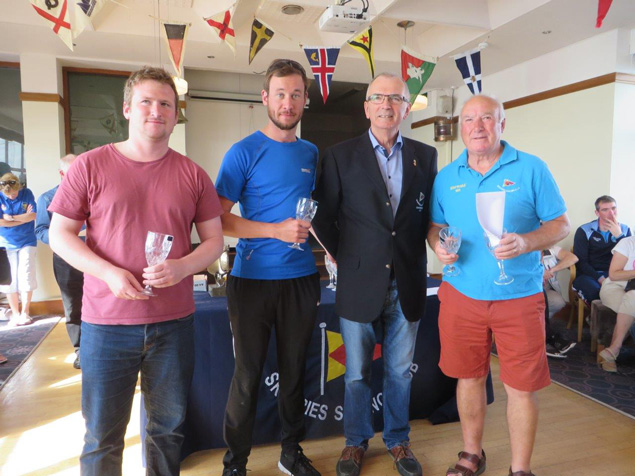 Second place overall goes to reigning National Champion and local Skerries boat Sam Shiels on 189 Azeezy with his crew Doire Shiels and Peter Bissett
Second place overall goes to reigning National Champion and local Skerries boat Sam Shiels on 189 Azeezy with his crew Doire Shiels and Peter Bissett
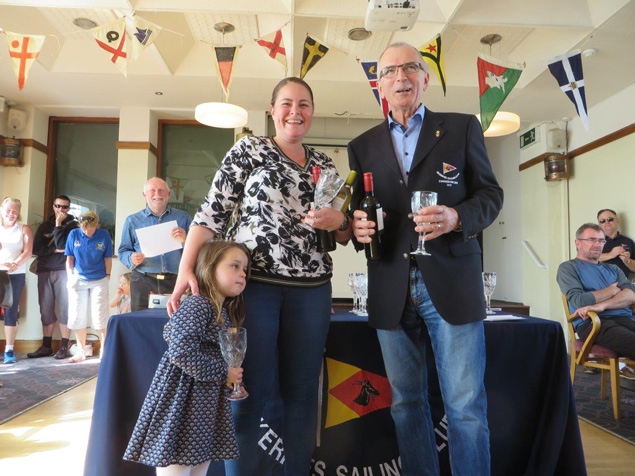 Third place overall goes to 123 Vee helmed by Jim Carthy with crew Paula and Muriel Carthy from Rush Sailing Club
Third place overall goes to 123 Vee helmed by Jim Carthy with crew Paula and Muriel Carthy from Rush Sailing Club
#RNLI - Skerries RNLI launched on Wednesday afternoon (5 July) after the coastguard received a report from lifeguards on Rush beach of swimmers in difficulty some 500 metres off shore and at risk of being pulled out to sea.
The Skerries lifeboat launched with volunteer David Knight at the helm and crewed by Ian Guildea, AJ Hughes and JP Tanner to check on the group.
The crew made their way towards Rush and began a search of the area. After stopping to speak to a group of kayakers, it became apparent that the lifeguards on the beach had mistaken them for a group of swimmers.
Once it was established that there was nobody in danger, the lifeboat was stood down and returned to Skerries.
Speaking about the callout, Skerries RNLI lifeboat press officer Gerry Canning said: “In this case it was a false alarm with good intent. But we would remind everyone, if you see someone in trouble in the water, dial 999 and ask for the coastguard.”




























